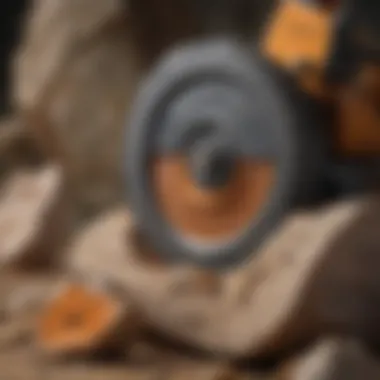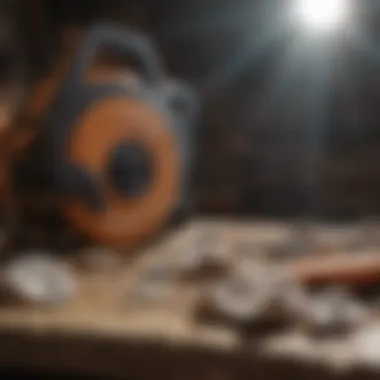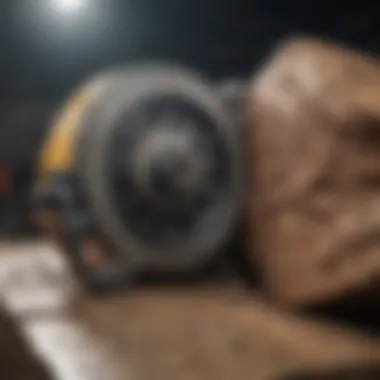Rock Saws: The Ultimate Guide for Geode Cutting


Intro
Rock saws are invaluable tools in the realm of mineralogy, particularly for those interested in working with geodes. These unique geological formations provide insight into the Earth's history and present stunning displays of crystal formations. However, cutting geodes requires specialized equipment to preserve their beauty and integrity. Understanding the nuances of rock saws can greatly enhance the experience for rock and fossil collectors.
With the right saw, enthusiasts can transform rough geodes into beautiful, polished specimens. This not only aids in showcasing the inner beauty of geodes but also allows for scientific examination. In this guide, we will explore the various types of rock saws available, their specific features, and how to safely operate them.
To thoroughly appreciate the art of cutting geodes, one must first understand the equipment necessary for the task.
Preface to Rock Saws and Geodes
Understanding the relationship between rock saws and geodes is critical for anyone interested in mineralogy or rock collecting. The primary purpose of this section is to elucidate how rock saws facilitate the cutting of geodes, transforming rough stones into mesmerizing specimens. The intricate process of cutting geodes requires a specialized approach, hence understanding the types and features of rock saws is indispensable. This exploration sheds light on how the correct tools enhance aesthetic, geological, and collectible values of geodes.
Understanding Geodes
Definition and origin of geodes
Geodes are geological formations that often contain mineral-rich crystals within a hollow cavity. They originate from volcanic or sedimentary processes over millions of years. These formations begin as bubbles in volcanic rock or sediment, which eventually fill with mineral deposits as water seeps through.
One key characteristic of geodes is their variance in appearance, which can be influenced by their formation environment. This characteristic makes geodes particularly attractive to collectors. Their unique interior designs often include quartz or amethyst crystals, adding to their allure. The formation process of geodes is slow and complex, providing a captivating narrative for collectors and mineral enthusiasts. This historical depth increases their value and interest, presenting both advantages and unique challenges when cutting them.
Types of geodes and their compositions
Geodes can be composed of various minerals, each type presenting distinct characteristics and visual appeal. Common types include quartz, amethyst, and calcite geodes. The compositions of these minerals determine their beauty and value, making an understanding of these types essential for collectors.
For example, a quartz geode can appear clear or milky, with complex crystal structures, while an amethyst geode showcases distinct purple hues. These variations offer specific advantages, as they attract different types of collectors, leading to diverse applications. Thus, knowing the types and their properties guides choices in cutting and showcasing geodes effectively.
The Role of Rock Saws
Importance in cutting geodes
The role of rock saws in cutting geodes cannot be overstated. They are essential for making precise cuts that reveal the hidden beauty inside geodes. Unlike standard saws, rock saws use specialized blades designed to handle the hardness of these formations. Their precision ensures that collectors can maximize the beauty of their specimens without risking damage.
Additionally, rock saws facilitate the extraction of clean-cut faces on geodes, which may be necessary for both display and analysis. Knowing the correct usage of rock saws is critical for geology professionals and hobbyists alike. The importance of these tools reflects directly on the quality of the final product, influencing the overall satisfaction of collectors.
Overview of applications in geology and collectibles
The applications of rock saws extend beyond mere geode cutting. They are utilized in geology for research, education, and exploration of mineral content. Collectors use rock saws to prepare specimens for display, enabling a deeper appreciation of their purchases.
The unique feature of these tools lies in their adaptability. Whether for academic research or hobby collecting, rock saws play a vital role in preserving the integrity and beauty of geodes. Understanding these applications enhances the collector's experience and promotes responsible handling and cutting techniques.
Types of Rock Saws for Geodes
The selection of the right type of rock saw is essential when cutting geodes. Each type has distinct advantages and limitations that cater to different levels of expertise, material types, and desired outcomes. Understanding these various saws will empower collectors and enthusiasts to make informed decisions, improving their cutting techniques and resulting precision. This can enhance both the aesthetic quality of the geode and the overall experience of the cutting process.
Diamond Blade Saws
Advantages and limitations
Diamond blade saws are widely recognized in the rock cutting community for their exceptional ability to slice through hard materials. The key characteristic of these saws is their diamond-encrusted blades. This feature not only contributes to their cutting effectiveness but also makes them suitable for various rock types, including the most rigid geodes. A major advantage is durability. The blades can withstand high temperatures and resist wear over time. However, cost is a notable limitation since diamond blades tend to be more expensive than other types. But for serious enthusiasts and collectors, the investment often pays off in performance and precision.


Best practices for usage
Using diamond blade saws effectively requires attention to detail. A fundamental aspect involves steady feeding rates; this ensures a clean cut without damaging the gem or the blade. It is also recommended to use water cooling systems to further minimize heat and dust during the cutting process. This is crucial because overheating can lead to blade damage and poor finish. Implementing these best practices ensures that collectors achieve optimal results, preserving the integrity of the geodes while protecting the saw itself.
Tile and Wet Saws
Features that benefit geode cutting
Wet saws, such as tile saws, have features that can make them advantageous for cutting geodes. A key element is the continuous water supply, which cools the blade and suppresses dust. This not only enhances visibility and cleanliness but also protects the geode from thermal expansion that can cause cracks. The ability to make fine adjustments in the cutting angle is another significant benefit. This control allows users to create precise cuts that can reveal stunning interior patterns of geodes without damaging them.
Specific considerations for operation
Using tile and wet saws requires awareness of specific operational considerations. First, the need for a consistent water supply is important for effective cooling and cutting. Users must ensure that they have the right connections to maintain this flow. Additionally, the stability of the work area is crucial to prevent vibration during cutting, which can alter the cut's accuracy. Utilizing a stable tabletop or platform enhances safety and the overall outcome of the cutting process.
Band Saws
Criteria for selecting a band saw
When it comes to band saws, several criteria must be considered to ensure an effective choice. A key element is the blade width and tooth count. Blades should have a fine tooth to allow intricate cutting of the often delicate structures within geodes. Moreover, the saw's throat depth must be adequate for the size of geodes being cut. While band saws may not perform as well on more rigid materials compared to diamond saws, they are favored for their ability to handle various shapes and sizes, especially for more complex cuts.
How band saws enhance precision
The design of band saws significantly enhances precision when cutting geodes. Their continuous blade motion allows for smoother cuts, which is important for preserving the intricate designs within a geode. Additionally, the controlled feed rate can mitigate the risk of veering off the intended path during a cut. This precision makes band saws a popular choice among collectors aiming for detailed and intricate cuts. However, they also require regular maintenance to keep the blades sharp and functioning effectively, which is essential for optimal performance.
Key Features of Rock Saws
Understanding the key features of rock saws is essential for anyone interested in cutting geodes. These features significantly impact the effectiveness and efficiency of the cutting process. Insight into blade type, motor power, and table design helps collectors and enthusiasts make informed choices tailored to their needs.
Blade Type and Quality
Durability and efficiency
Durability and efficiency are two critical attributes of a rock saw blade. A robust blade ensures longevity, reducing the frequency of replacements, while efficiency relates to how effectively it can cut through tough geode materials. Typically, diamond blades are favored for their hardness and ability to cut through tough stones while maintaining sharpness over time. This combination makes them a popular choice among collectors who seek precision in their cuts, allowing for clean and smooth finishes.
"A quality blade can be the difference between a successful cut and a ruined geode."
Though durable, the cost of high-quality blades can be higher. This investment usually pays off in the long run due to decreased wear and tear, illustrating that durability equates to long-term savings.
Types of materials used
The types of materials used in blade construction often dictate performance. Common materials include diamond segments, carbide, and high-speed steel. Diamond segments are usually preferred because they provide a high cutting speed and longer lifespan. They can also effectively handle both hard and soft materials, making them versatile.
However, it's important to note that while diamond blades offer exceptional performance, they can be more expensive than other options. Selecting the right material is essential for achieving desired results, as it can affect both the quality of the cut and the longevity of the saw.
Motor Power and Speed
Influence on cutting performance
Motor power and speed are pivotal factors influencing a rock saw's cutting performance. A powerful motor can maintain consistent speeds even under load, which is crucial for cutting harder materials like geodes. Higher RPM can also lead to smoother cuts. Generally, saws with variable speed settings are more favorable as they allow users to adjust based on the hardness of the geode being cut.


A motor with sufficient torque ensures that the saw can easily penetrate tough geode surfaces, enhancing the cutting process. Therefore, when choosing a rock saw, makers should prioritize motors with adequate power for the job at hand.
Matching motor specs to geode hardness
Matching motor specifications to the hardness of the geode is essential for optimal cutting. Geodes vary in hardness, and using the right motor specifications can greatly influence how efficiently a rock saw operates. Using too little power on a hard geode can lead to overheating or damage to both the blade and the saw itself.
Conversely, overpowered motor settings on softer geodes may cause excessive vibrations, leading to imprecise cuts. Understanding the hardness spectrum of geodes helps users select the right motor specifications, ensuring better performance and yields during cutting.
Table Design and Stability
Importance of a sturdy base
Having a sturdy base in a rock saw contributes significantly to stability during operation. Stability ensures accurate cuts and keeps the saw aligned as it moves through the material. A robust table design minimizes vibrations and reduces the risk of accidents, especially while cutting intricate patterns in geodes.
An unstable table can compromise both user safety and the quality of cuts.
Adjustability and ease of use
Adjustability in rock saw tables allows users to tailor the setup based on their specific cutting tasks. Features such as drop-down extensions or adjustable height can enhance ease of use, making the saw more versatile for various geode sizes. This feature is particularly beneficial for collectors and enthusiasts as it accommodates different cutting techniques and preferences.
In summary, understanding the key features of rock saws—including blade type, motor power, and table design—ensures that collectors avoid mistakes and improve cutting effectiveness. This knowledge not only fosters better results in geode cutting but also enhances the overall experience in this specialized craft.
Using a Rock Saw: Techniques and Safety
Using a rock saw effectively requires a comprehensive understanding of both techniques and safety measures. The successful cutting of geodes relies significantly on how one operates the saw, and attention to safety is paramount. Proper techniques enhance precision and reduce errors while ensuring the desired results. Incorporating safety practices protects both the operator and the materials involved. Thus, grasping these elements is crucial for anyone involved in geode cutting, whether for personal interest or professional purposes.
Setting Up the Equipment
Checklist before you start
Creating a checklist before cutting is essential. It helps ensure all tools and materials needed are available. A thorough approach establishes preparedness that contributes directly to cutting efficiency and safety. The key characteristic of this checklist involves organization. It compiles all items required into one easy-to-follow format, thus minimizing the chance of forgetting important steps or tools. The primary benefit is improved focus during the cutting process. It avoids disruptions that arise from searching for missing equipment. Incorporating a simple checklist not only streamlines the workflow but enhances overall productivity.
Environmental considerations
Environmental considerations play a significant role in geode cutting using a rock saw. Assessing the workspace is crucial to ensure safety and efficiency. The key characteristic refers to ensuring proper ventilation and keeping the area clean. A clean environment minimizes the risk of accidents and enhances visibility, which is beneficial for precision cutting. The unique feature of this approach is that it allows for adjustments based on weather and surroundings, such as ensuring dry conditions to prevent slipping. Such considerations support both safety and operational efficiency, resulting in better outcomes during cutting sessions.
Cutting Techniques
Proper feed rates
Understanding proper feed rates is vital when using a rock saw. It refers to the speed at which the material is fed into the blade. This aspect influences the quality of the cut significantly. The key characteristic is finding a balance that allows effective cutting without forcing the blade. A proper feed rate contributes to smoother cuts and reduced wear on the blade. The unique component in this context is the adjustment according to the geode's hardness. Improper rates can lead to chipping or even damaging the geode. Thus, maintaining optimal feed rates is critical for achieving the best results while prolonging blade life.
Adjustments for varying geode sizes
Adjusting for varying sizes of geodes directly affects the efficiency of the cutting process. Different sizes require corresponding adjustments in machine settings and cutting techniques. The characteristic of modulation is of utmost importance here. This allows the operator to switch techniques based on the size of the geode being cut. The benefit is greater control and precision, ensuring each geode is treated appropriately. Incorrectly adjusting for size can lead to uneven cuts and wasted time and resources. Hence, understanding how to adapt cutting methods is essential for successful geode cutting.
Safety Precautions
Personal protective equipment (PPE)


Using appropriate personal protective equipment (PPE) cannot be overstated. PPE components such as safety goggles, gloves, and ear protection serve a crucial role in protecting individuals from possible injuries. The key characteristic of PPE is its preventative nature. It safeguards against shards of rock, noise from machinery, and any other hazards presented by cutting geodes. The unique feature of wearing PPE is to establish a culture of safety. Failing to utilize proper equipment can lead to preventable accidents and injuries, which can be detrimental. Investing time in ensuring that proper PPE is available and worn, ultimately contributes to a safer workspace.
Emergency procedures
Establishing emergency procedures for geode cutting is a critical safety measure. These procedures outline steps to take during an accident or equipment failure. The key characteristic of these procedures is their ability to minimize harm in unexpected situations. Quick responses can save lives and reduce the severity of injuries. The unique aspect of having clear procedures is the sense of readiness they instill in operators. Each person can handle potential emergencies confidently. Neglecting to create and practice emergency procedures can lead to confusion during critical moments, substantially increasing risks. Therefore, having established and communicated emergency protocols is essential for safety in the cutting process.
Maintaining Your Rock Saw
Proper maintenance of a rock saw is crucial. Regular care ensures longevity and optimal performance. Many collectors may overlook the importance of maintenance, leading to reduced cutting efficiency or potential damage. By focusing on upkeep, users can prevent costly repairs and enhance the overall experience of cutting geodes. Understanding the proper practices helps maintain cutting precision and safety.
Regular Maintenance Practices
Blade care and replacement
Blade care is an essential aspect of maintaining a rock saw. Blades endure significant wear during cutting. A well-maintained blade improves cutting accuracy and efficiency. Users should regularly check for signs of dullness or damage. When replacement is necessary, high-quality diamond blades are the preferred choice due to their durability and effectiveness. A sharp blade cuts smoothly through geodes, preserving the integrity of the specimen. On the contrary, a worn blade can lead to uneven cuts or damage to the rock. Therefore, timely replacement is vital.
Cleaning components to prevent wear
Cleaning the components of a rock saw is critical for preventing wear and tear. Dust and debris can accumulate, leading to operational issues. Regular cleaning ensures that moving parts function correctly, reducing friction. A clean saw also promotes better cooling during operation, which is essential for blade longevity. Users should clean the saw after every use, focusing on the blade and any accessible components. This practice minimizes the risk of costly repairs and maintains peak performance.
Troubleshooting Common Issues
Identifying cutting problems
Identifying cutting problems early can save time and resources. Users may encounter issues like uneven cuts or excessive vibration. These problems may stem from multiple sources, such as a dull blade, improper setup, or misalignment. Recognizing these issues quickly facilitates more efficient repairs. Knowledge of common symptoms allows users to take corrective action before minor issues expand into significant challenges.
Solutions for performance failures
Solutions for performance failures can vary based on the identified problem. For instance, if a saw is cutting unevenly, potential solutions include adjusting the table or replacing the blade. Other common adjustments may include tightening loose components or recalibrating settings. Understanding these solutions helps users maintain effective operation. Moreover, being proactive in addressing failures supports the longevity of the equipment, making it a wise investment in the long term.
Maintaining a rock saw is essential for both performance and safety. Regular upkeep can significantly enhance the user experience.
Finale
The conclusion of this article serves to consolidate the knowledge accumulated about rock saws specifically for cutting geodes. This section emphasizes the significant aspects of both rock saws and the techniques necessary for effective and safe operations. Understanding these elements is crucial for enthusiasts and collectors who engage with geodes, as it enables them to achieve their desired outcomes while minimizing risks.
Recap of Key Points
Summary of rock saw features and uses
The summary of rock saw features and uses highlights the core benefits that these tools provide. Notably, rock saws often feature diamond blades which enhance cutting efficiency. They are designed to handle the hardness of geodes effectively, which makes them a popular choice among collectors. The unique aspect of these saws is their ability to cut precisely along intricate lines, preserving the aesthetic integrity of the geodes.
Importance of proper techniques
The importance of proper techniques cannot be overstated in this context. Adhering to established cutting methods maximizes the potential of rock saws in achieving clean cuts. It is beneficial for ensuring a longer lifespan for both the tools and the specimens. A unique feature of utilizing proper techniques is adaptability; these methods can be adjusted for various sizes and shapes of geodes, which is essential for optimal results.
Final Thoughts on Geode Collecting
Value in collecting
The value in collecting geodes goes beyond aesthetic pleasure; it reflects a deeper appreciation for mineralogy. Collectors often seek unique specimens that showcase nature's artistry. The unique aspect of geode collection is the thrill of discovery—finding a geode, cutting it open, and revealing its inner beauty enhances the overall experience. This, however, requires adequate knowledge about the cutting processes discussed earlier to avoid damage.
Future trends in geode exploration and cutting
Looking toward the future, the trends in geode exploration and cutting signify a growing interest in sustainable practices. As collectors become more aware of environmental impacts, there is a shift towards using methods that minimize waste. This trend is advantageous as it caters to both collector satisfaction and ecological responsibility. Furthermore, advancements in technology may lead to improved saw designs, enhancing efficiency and accuracy in cutting geodes effectively.
In closing, the fusion of proper techniques, suitable tools, and a reverence for the natural world marks the essence of successful geode collecting. As this article demonstrates, a comprehensive understanding of rock saws plays an integral role in this journey.















